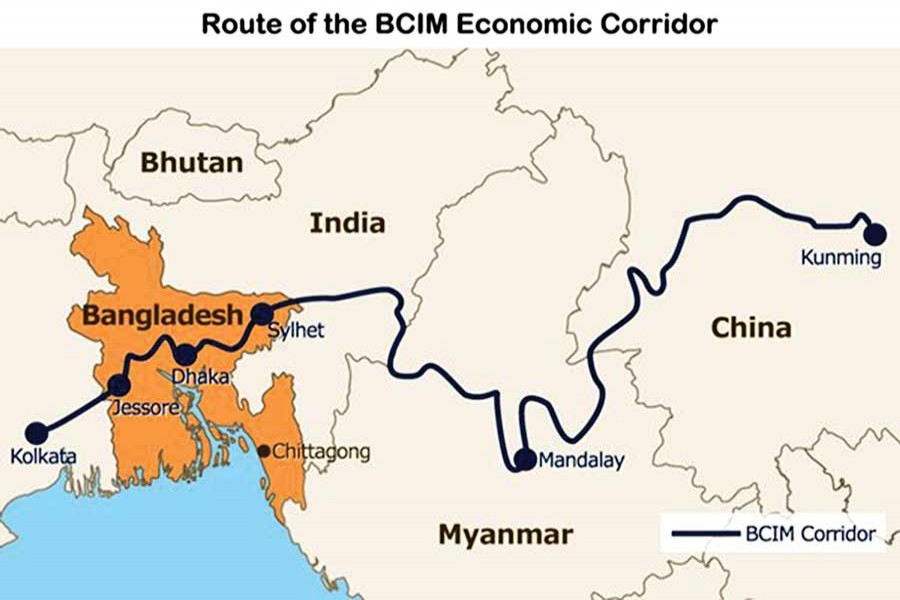
 The Bangladesh-China-India-Myanmar Economic Corridor (BCIM-EC) is a sub-regional initiative for economic cooperation among the four countries to develop multimodal connectivity that would link East, Southeast and South Asia. The economic corridor, known as the Southern Silk Road, is also known to be part of the Belt and Road Initiative (BRI), the largest global-scale regionalization initiative pioneered and championed by China.
The Bangladesh-China-India-Myanmar Economic Corridor (BCIM-EC) is a sub-regional initiative for economic cooperation among the four countries to develop multimodal connectivity that would link East, Southeast and South Asia. The economic corridor, known as the Southern Silk Road, is also known to be part of the Belt and Road Initiative (BRI), the largest global-scale regionalization initiative pioneered and championed by China.
The BCIM-EC was initially conceptualised by think tanks, academics and civil society members in China, Bangladesh and India, and began as a track II initiative, which later received political and governmental support (transforming into a track I initiative) in the year 1999 through the Kunming Initiative, the Conference on Regional Cooperation and Development among the four countries, approved later as the Kunming Initiative. Although the initial plan of BCIM initiative was development of multimodal infrastructural connectivity (through rail, road, waterways and air links), the BCIM Forum (an evolved version of Kunming initiative) proposed the corridor to provide greater market access for the constituent countries and facilitate multilateral trade, investment and joint ventures in industries of the specific economic growth zones. Hence, with time the BCIM-EC conceptually evolved into a larger form of sub-regional cooperation for development of economic growth zones.
Despite being an older initiative that has been extensively studied by scholars, new dynamics of BCIM-EC have emerged in light of China's Economic New Normal (structural economic changes) and the BRI.
One interesting dynamic, is the shift in ownership of the initiative. The idea of BCIM was conceived by two scholars, from Bangladesh and China respectively, but the debate over who conceptualised it first made the origins blurry. For policy-makers, such debates are irrelevant as long as scholars from the constituent countries mutually cooperate and contribute to development of the regional initiative. Eventually, we have experienced collaboration between scholars from all four countries dedicating time and effort to research, feasibility studies, and exploring the various modes of cooperation. When the Kunming Initiative transformed into BCIM Forum, all countries had equal stakes and skepticisms regarding the development and feasibility of the initiative, due to Myanmar's domestic political unrest, and Sino-Indian political discrepancies. Despite the challenges, the BCIM gradually gained momentum (since 2010) through a series of intergovernmental visits, discussions and political buy in of policy makers as evident in the official joint statements of each visit. Besides, the formation of joint study groups and their first official discussion in 2013, along with the 2,800-km-long Kunming to Kolkata car rally boosted enthusiasm for infrastructural development and implementation of the economic corridor. However, in 2014, when President Xi Jinping announced the BRI, China's focus shifted largely. With India looking at the BRI as a sovereignty threat (because of the development of China Pakistan Economic Corridor), the momentum of BCIM fell largely. Eventually, as the BCIM-EC officially got recognised as the Southern Silk Road being part of the BRI, which is pioneered by China, the ownership of the initiative shifted largely on China's side. For beneficiaries of the corridor, it practically does not matter who conceptually owns a regional initiative, but in politics and international relations it matters largely dictating the power games and regional power balances. Now, even in scholarly discussions, the BCIM is more relevant as being the Southern Silk Road rather than an individual regional initiative developed through multilateral cooperation.
This shift in ownership has two critical repercussions; one is that the BRI is largely mobilised through bilateral cooperation between China and other countries, China being the root of the initiative. Hence it changes the cooperation dynamics of the BCIM-EC from a more multilateral to China-centric bilateral cooperation of the other three countries. The second issue is the fact that the Southern Silk Road is not at the heart of the BRI. The BRI primarily constitutes of land connectivity between China and Eurasia, and maritime connectivity to Africa and the Persian Gulf through the Indian Ocean. Also, the most comprehensive landmark project of BRI is the China Pakistan Economic Corridor (CPEC), a cluster of infrastructure development projects including the Gwadar port, Karakoram Highway and extension of railway network. The CPEC runs through the disputed region of Jammu and Kashmir that is administered by Pakistan. South Asian politics and disputes hence place the BCIM-EC and CPEC at competing ends. Even on the Maritime Silk Road, all the BCIM countries are not connectivity nodes, diluting the importance of the economic corridor further.
Identifying this weakness and imbalance in South Asian footprint of the BRI, in June 2017 the Chinese government called for linking the CPEC and BCIM-EC through marine routes in the NDRC paper called "Vision for Maritime Cooperation under the Belt and Road Initiative". However, the paper did not discuss the modus operandi of such connectivity. On one hand such a vision might help integrate the South Asian region but at the same time may attract backlashes from India for unilateral decision making.
Sino-Indian rivalry and contentions are a major impediment to shifts in economic policies. Economic rivalry extends to Prime Minister Narendra Modi's new initiative Mausam Project. Mausam stretches from east Africa, along the Arabian Peninsula, past southern Iran to the major countries of South Asia and thence to Sri Lanka and Southeast Asia, to strengthen India's cultural and strategic dominance in the region as an answer to China's BRI. Besides, Sino Indian military standoff at the Doklam that lasted for more than two months severed old wounds. The unlikely withdrawal of troops before the September BRICS Summit in Xiamen indicates closed door diplomacy and political strong-arming. Such outlook may seem promising for initiatives with bigger stakes and global prominence, like the BRICS, while somewhat opposite for the weaklings like the BCIM-EC.
Despite the geopolitical concerns that threaten the implementation of the BCIM-EC, there still remains critical economic reasons for the corridor to receive political attention. This is specifically in light of China's changing economic structure and the New Normal.
China has been achieving double-digit aggregate economic growth for the last three decades, galloping like a racing horse that requires good stabling. China's economy has been heavily dependent on debt-fuelled investment, particularly in infrastructure, housing and heavy industry. As a result, China has been exporting its infrastructure development capabilities to other developing countries, has experienced exponential boom in housing prices and over capacity in heavy industries. Simultaneously, rising wages have been eroding the comparative advantages of cheap labour and many of the light industry manufacturers are struggling for razor thin margins. This slowing of economic growth rate coupled with the need to restructure economic constituents by politicians and policy makers is known as the New Normal. The BCIM-EC can come to help in achieving this new normal and successful transition in restructuring the economy.
While Chinese domestic consumption is gradually rising, it needs to balance the excessive foreign reserves through feasible outward investments. Bangladesh and Myanmar are critically in need of developing the manufacturing sector of their economies, and shifting many of the low-profitable light industries to these countries can provide China the opportunity to capitalise on changing economic dynamics. Besides, the heavy industries running excess capacity can support the development of infrastructure in the BCIM-EC providing the critical raw materials required, while China explores another zone to export its infrastructure development capabilities. Comparatively low wage rates and price indices in Bangladesh and Myanmar can be utilised as an opportunity for Chinese investors to diversify their portfolios and for China to mature its economic policies. For India, the North-Eastern states still lack much-needed economic growth, investment and attention compared to the rest, and the proximity of this geographical region to Bangladesh and Myanmar provides natural advantage for Chinese investments.
Given that BCIM-EC has been in talks and studies for a long period of time and some key areas of implementation have been mapped out by the Joint Study Group of the BCIM Forum, mobilisation is within arms-length and dependent on multilateral policies made and deals signed. Besides, the fact that the countries are natural neighbours, cross border trade is immense with mutual dependence for certain goods. Trade in intermediate goods between the BCIM countries is strong for textiles and clothing industry, agriculture, horticulture and agro-processing, wood processing, metal processing, industrial chemicals and minerals (mining and processing) encompassing between 20 per cent to 60 per cent of total trade. These value chains are already robust within the BCIM network, and can be integrated to generate greater benefits for the BCIM even without having a free trade zone. All that is required is joint political nudge from the two giants, China and India.
History has encountered even the most rigid of regimes coming out of closed shells to meet the needs of a stronger economy and satisfied economic players. China's clientelist model of state-economy coexistence defined by patron-client relationship between the state and the economic players is the biggest example of the strength of private sector or economic actors. Growing SMEs and entrepreneurship in South Asian countries also point towards the same trend. Hence, there can be hope that advocating feasible policy changes for integration of key profitable value chains will bring in change, where scholarly advocacies have had limited success.
Given the current scenario, predicting a definitive future of BCIM-EC would be premature as there are a number of factors stimulating and incentivising policies. On one hand, the initiative is weakened in priority, and on the other, it is one of the lowest lying fruits of greater regional cooperation. The future, hence, depends on direction of the political wind.
Orpita Oysharja is a Master in Public Policy, Peking University.
© 2024 - All Rights with The Financial Express
